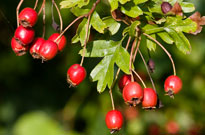 |
 |
 |
 |
 |
 |
 |
 |
 |
 |
Wild About Gardens Newsletter December 2012 |
 |
 |


|
 |
Deciduous trees and shrubs are bare or nearly so, but if you are lucky, or have planned well, your garden can still look well-decorated this festive season. Adornment may come from the plants you’ve put in the garden, or from the little extras you add for wildlife
|
 |
You may have colourful berries from hawthorn, holly or pyracanthas. These give food and shelter to birds while brightening up your outlook. Or, you may have architectural perennials that glisten with dew or glitter with frost in the morning. Their decorative stems and stalks are fantastic overwintering spots for insects like ladybirds.
You can also spread your own Christmas enchantment around the garden. For outdoor baubles, hang fatballs from your trees. Small garden birds, like blue tits, will really appreciate this addition to their winter diet. For a seasonal splash of red, fix bright apples to special feeders, or slice and sprinkle them on your lawn for blackbirds to find.
Finally, as you look back over your year in the garden, you may like to share your stories with a wider audience. Outline Productions are making a series for the BBC and are looking for enthusiastic and passionate wildlife gardeners who delight in sharing their wildlife gardening tips and secrets.
|
 |

|
 |
Things to do
- If you’d like more trees or shrubs, now (and anytime between October and March) is a good time to plant them, especially if they are bare rooted. Try natives such as rowan, crab apple, hawthorn or silver birch, for their added value for wildlife.
- It’s a traditional time to coppice trees and shrubs like hazel. Coppicing keeps plants a manageable size, and lets in more light, allowing bulbs and ground cover plants to flourish.
- Use the twigs and prunings to create mini log piles to shelter invertebrates and amphibians over the winter.
More things to do in December |
 |
 |

|
 |
|  |
 |
 |
 |
|
 |
|
|


